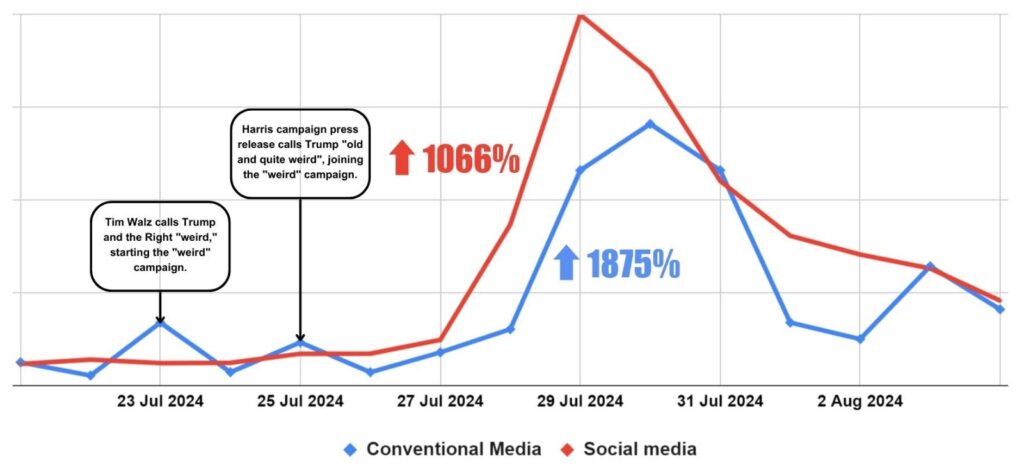Start of “Weird” Campaign
Since July 2024, the Weird campaign against Trump has become central to the Democrats 2024 strategy against Donald Trump and JD Vance.
The narrative began with Tim Walz’s critique of Trump during his July 23 appearance on Morning Joe, where he labeled Trump and the Right’s focus on attacking childless women and banning books as ‘weird’ and ‘troubling.’
The campaign gained further momentum on July 25, 2024, when Kamala Harris 2024 campaign issued a press release describing Trump as “old and quite weird,” reinforcing the idea that he was out of touch with voters.

Power of Labeling
By labeling Trump and Vance as “weird,” Democrats highlighted their disconnect from mainstream values during the Trump 2024 election, influencing public opinion and making it harder for Trump to connect with undecided voters.
Over time, the Trump weird narrative became a key part of how people viewed Trump, showing how political labeling can influence public opinion and shape how voters see a candidate.

Life Imitates Art
The weird campaign against Trump and JD Vance 2024 was similar to tactics used in the Netflix series House of Cards.
In Season 1, Episode 6, Frank Underwood uses the term “disorganized labor” to sway public opinion against a teachers’ union, making them seem chaotic and unreliable. This label, amplified by the media, quickly defines the union, just as “weird” has been used to portray Trump and Vance as out of touch.
Both strategies use media and repetition to shape perceptions, demonstrating how they can reshape views and influence actions. In House of Cards, the label creates fear and anger, while the “weird” campaign uses humor to create discomfort.
Media and Public Reaction

Source: Google Trends (USA)
The Democrats’ campaign led to a significant rise in Google searches, especially for “Weird Trump.” This shows how well the “weird” label connected with people’s views of Trump as different from the norm.
This rise in searches not only showed public interest but also helped spread the message further. As more people looked up and talked about “Weird Trump,” the term became more visible in the media, making it a central part of public conversation and ensuring it stayed in the spotlight.
Trends in Conventional Media Coverage and Social Media Mentions of “Weird Trump” Over Time

Source: Social Listening and Media Intelligence
The Democrats’ campaign led to a significant rise in Google searches, especially for “Weird Trump.” This shows how well the “weird” label connected with people’s views of Trump as different from the norm.
The rise in searches not only showed public interest but also helped spread the message further, showcasing the media influence on elections and how it shaped the narrative around ‘Weird Trump.’ As more people looked up and talked about ‘Weird Trump,’ the term became more visible in the media, making it a central part of public conversation and ensuring it stayed in the spotlight.
Trump Net Favorabilty Rating in Swing States

The “weird” label appears to correlate with a decrease in Donald Trump’s net favorability in key swing states. As the label gained traction, Trump’s ratings fell in several states, suggesting it may have influenced voter perception and weakened his image.
While this drop indicates that the label could have shaped public opinion, it’s important to remember that other factors likely contributed, making it more challenging for Trump to maintain support from undecided voters.
Why Weird Works
- Simple and Relatable
The word “weird” is easy for people to understand and connect with. It’s a powerful label that frames opponents in a clear way without being too harsh, making it effective in shaping how people think. - Creating Contrast and Emotion
Calling Trump and Vance “weird” shows how they differ from mainstream values. This approach resonated with undecided voters, making the Democrats seem more in touch with everyday concerns. - Using Humor to Connect
The “weird” label also uses humor to make the campaign more engaging. This strategy, known as laughtivism, helped build a sense of community among voters while subtly weakening the opponents’ image. - Strategic Repetition and Amplification
Democratic leaders repeatedly used “weird” in speeches and media, making sure the label stuck. As the term spread through traditional and social media, it became a central part of the campaign, showing how repetition is key in effective communication.
Conclusion
The “weird” campaign underscores the power of strategic labeling in shaping public perception. By choosing a simple and relatable word like “weird,” Democrats effectively portrayed Trump as disconnected from mainstream values.
The label’s impact grew through humor and repetition, making the message more engaging and subtly weakening Trump’s image. Its frequent use in speeches and media ensured that “weird” became central to public discourse.
This campaign shows the importance of strategic labexling in communication. A carefully chosen label, reinforced by consistent messaging, can significantly shape public perception and control the narrative.
Have you noticed any examples of effective labeling in Indonesian politics? Share your insights with us.
Written by Syanditya Yanuar Utama, Analyst
